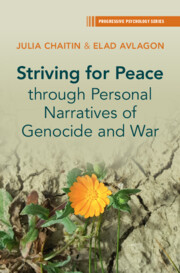1124 results
5 - The Pain of Separation
-
- Book:
- Childhood, Pain and Emotion
- Published online:
- 21 March 2025
- Print publication:
- 03 April 2025, pp 152-196
-
- Chapter
- Export citation
Introduction: Re-examining Asia-Pacific War Memories: Grief, Narratives, and Memorials
-
- Journal:
- Asia-Pacific Journal / Volume 20 / Issue 10 / May 2022
- Published online by Cambridge University Press:
- 14 March 2025, e2
-
- Article
- Export citation
Natural Disaster, Trauma and Activism in the Art of Takamine Tadasu
-
- Journal:
- Asia-Pacific Journal / Volume 13 / Issue 7 / February 2015
- Published online by Cambridge University Press:
- 14 March 2025, e6
-
- Article
- Export citation
Fiction from Unstable Ground: The Imagination of Disaster in the Aftermath of the Kantō Earthquake
-
- Journal:
- Asia-Pacific Journal / Volume 21 / Issue 8 / September 2023
- Published online by Cambridge University Press:
- 14 March 2025, e3
-
- Article
- Export citation
Beyond the “Empire of Trauma”: Cold War Psychological Science and the Bombings of Hiroshima and Nagasaki
-
- Journal:
- Asia-Pacific Journal / Volume 21 / Issue 12 / December 2023
- Published online by Cambridge University Press:
- 14 March 2025, e6
-
- Article
- Export citation
The role of trauma, attachment, and voice-hearer’s appraisals: a latent profile analysis in the AVATAR2 trial
-
- Journal:
- Psychological Medicine / Volume 55 / 2025
- Published online by Cambridge University Press:
- 27 February 2025, e65
-
- Article
-
- You have access
- Open access
- HTML
- Export citation
Mapping connections between complex post-traumatic stress disorder and psychotic-like experiences among adolescents: a Gaussian and Bayesian network study
-
- Journal:
- Psychological Medicine / Volume 55 / 2025
- Published online by Cambridge University Press:
- 25 February 2025, e61
-
- Article
-
- You have access
- Open access
- HTML
- Export citation

Striving for Peace through Personal Narratives of Genocide and War
-
- Published online:
- 22 February 2025
- Print publication:
- 13 February 2025
Chapter 34 - Serendipity on the Path to Developmental Resilience Science
-
-
- Book:
- Pillars of Developmental Psychology
- Published online:
- 14 February 2025
- Print publication:
- 20 February 2025, pp 383-394
-
- Chapter
- Export citation
A temporal network analysis of complex post-traumatic stress disorder and psychosis symptoms
-
- Journal:
- Psychological Medicine / Volume 55 / 2025
- Published online by Cambridge University Press:
- 20 February 2025, e43
-
- Article
-
- You have access
- Open access
- HTML
- Export citation
Neighbourhood socioeconomic deprivation associated with poorer psychological therapy outcomes for PTSD: an audit of a single NHS Talking Therapies (IAPT) service
-
- Journal:
- The Cognitive Behaviour Therapist / Volume 18 / 2025
- Published online by Cambridge University Press:
- 19 February 2025, e9
-
- Article
-
- You have access
- Open access
- HTML
- Export citation
Chapter 39 - Trauma in Children
-
-
- Book:
- Core Topics in Paediatric Anaesthesia
- Published online:
- 06 February 2025
- Print publication:
- 13 February 2025, pp 440-455
-
- Chapter
- Export citation
Chapter 3 - Coping, or Not, with Genocide and War
- from Part I - Theoretical Background of the Book
-
- Book:
- Striving for Peace through Personal Narratives of Genocide and War
- Published online:
- 22 February 2025
- Print publication:
- 13 February 2025, pp 41-59
-
- Chapter
- Export citation
Chapter 9 - Personal Narratives of Genocide and Intractable War
- from Part III - Suggestions for Further Research and Peace Work on the Ground
-
- Book:
- Striving for Peace through Personal Narratives of Genocide and War
- Published online:
- 22 February 2025
- Print publication:
- 13 February 2025, pp 157-165
-
- Chapter
- Export citation
5 - Intellectual Work and Political Thought on the Peripheries
-
- Book:
- New Sudans
- Published online:
- 06 February 2025
- Print publication:
- 13 February 2025, pp 178-229
-
- Chapter
- Export citation
Psychotic experiences and disorders in adolescents and young adults with borderline intellectual functioning and intellectual disabilities: evidence from a population-based birth cohort in the United Kingdom
-
- Journal:
- Psychological Medicine / Volume 55 / 2025
- Published online by Cambridge University Press:
- 05 February 2025, e23
-
- Article
-
- You have access
- Open access
- HTML
- Export citation
Demographic and Injury Characteristics of Patients Injured in a Hailstorm
-
- Journal:
- Prehospital and Disaster Medicine / Volume 40 / Issue 1 / February 2025
- Published online by Cambridge University Press:
- 24 February 2025, pp. 43-47
- Print publication:
- February 2025
-
- Article
- Export citation
Chapter 9 - Trauma-informed practice
-
-
- Book:
- Student Engagement
- Published online:
- 22 December 2024
- Print publication:
- 16 January 2025, pp 214-242
-
- Chapter
- Export citation
Chapter 21 - Posttraumatic Stress Disorder
-
-
- Book:
- Fundamentals of Clinical Psychiatry
- Published online:
- 02 January 2025
- Print publication:
- 16 January 2025, pp 212-220
-
- Chapter
- Export citation
Trauma exposure, contextual stressors, and PTSD symptoms: patterns in racially and ethnically diverse, low-income postpartum women
-
- Journal:
- Psychological Medicine / Volume 54 / Issue 16 / December 2024
- Published online by Cambridge University Press:
- 14 January 2025, pp. 4747-4758
-
- Article
-
- You have access
- Open access
- HTML
- Export citation


